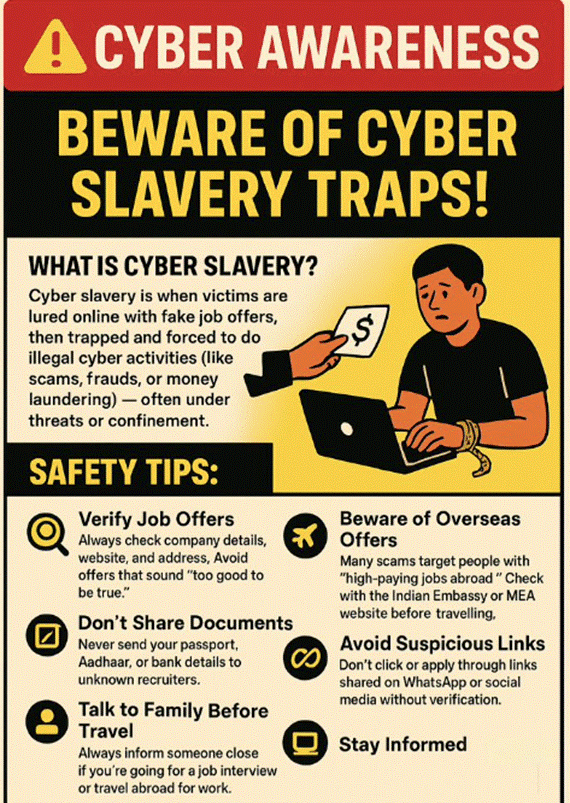Why is it in News?
- Nearly 500 Indian nationals have been rescued from cyber-slavery compounds in Myanmar.
- 4 victims are from Delhi; Delhi Police has made key arrests linked to trafficking networks.
- Highlights a rapidly expanding transnational cybercrime–trafficking nexus emerging as one of Asia’s major security threats.
Relevance
- GS3: Internal Security – cybercrime, trafficking networks, transnational syndicates, digital exploitation.
- GS2: Governance & Law Enforcement – immigration oversight, MEA–MHA coordination, regulatory gaps.

What is Cyber-Slavery?
- Form of human trafficking where victims are lured by fake overseas job offers.
- Once trafficked, victims undergo physical confinement, passport seizure, and psychological coercion.
- Forced to participate in cyber fraud, including:
- Investment scams
- Romance scams
- Online loan extortion
- Crypto fraud
- Operated by criminal syndicates in Myanmar, Cambodia, Laos, Thailand’s border zones.
Core Features:
- Trafficking + Digital exploitation + Organized cybercrime.
- Victims treated as “forced cyber labour”.
Modus Operandi (India–Southeast Asia Trafficking Route)
- Job offers posted on social media, WhatsApp, Telegram, LinkedIn lookalikes.
- Promises: customer service, gaming industry, IT support, crypto trading.
- Victims trafficked via Kolkata–Bangkok–Mae Sot or India–Dubai–Thailand routes into Myanmar.
- On arrival:
- Phones confiscated
- Confined in guarded buildings
- Compared to “digital sweatshops”
- Forced to meet daily scam targets
- Threats, beatings, starvation used as control
- Syndicates demand $4,000 (~₹3.6 lakh) ransom for release.
Specifics in the Delhi Case
- One Delhi victim trafficked in July, three in August.
- Traffickers demanded $4,000 for each release.
- Delhi Police arrested Danish Raja (24) and Harsh (30) for recruiting and facilitating travel.
- DCP (IFSO) Vinit Kumar: only two escape routes:
- Paying ransom, or
- Military-style raids by local authorities.
Why Cyber-Slavery is Emerging as a Major Global Threat ?
A. Multi-Billion-Dollar Criminal Industry (Interpol, UNODC)
- Estimated global cyber-slavery victims (2024): 220,000+ in Southeast Asia.
- Annual fraud revenue: $12–15 billion.
B. Perfect Convergence of Two Crimes
- High-volume cyber fraud + cheap trafficked labour.
- Industrial-scale online scams run like BPOs.
C. Tech-Driven Control Mechanisms
- AI-based surveillance inside compounds.
- Continuous digital monitoring.
- Restriction of communication, movement, identity.
D. Weak Border Governance
- Myanmar’s Shan and Karen regions controlled partly by militias, non-state groups.
- Criminal sanctuaries enable trafficking hubs.
India’s Emerging Vulnerability
- High youth unemployment → easy target for overseas job scams.
- Indians have been trafficked to: Myanmar, Cambodia, Laos, Vietnam, Thailand.
- Repeated MEA advisories (2022, 2023, 2024), yet rackets persist.
- Recruitment networks active in Delhi, UP, Bihar, Rajasthan, Punjab, TN.
Law Enforcement Response
India:
- Delhi Police IFSO cracking recruitment modules.
- CBI working with Interpol channels in earlier cases.
- MEA coordinating with Myanmar, Thailand for rescues.
- Lookout Circulars and immigration alerts on flagged recruiters.
International:
- Crackdowns by Thailand, Myanmar (limited), and Laos.
- UNODC urging states to treat cyber-slavery as “trafficking + cybercrime + organized crime”.
Structural Reasons for the Rise of Cyber-Slavery
- Cheaper to use trafficked labour than hire criminal experts.
- Syndicates can scale cyber fraud to tens of thousands of messages daily.
- Border conflict zones create law enforcement vacuums.
- Crypto transactions make tracing difficult.
- Growing global demand for online scams targeting Europe, US, India.
Impacts on India
- Increased cyber fraud reporting nationwide.
- Damage to India’s cyber reputation abroad due to scams traced to trafficked Indians.
- Families coerced to pay ransom.
- Diplomatic strain with Myanmar and Cambodia over repeated Indian rescues.
Policy and Security Gaps
- Inadequate cyber awareness among jobseekers.
- Weak monitoring of overseas placement agencies.
- No integrated Cyber Slavery Victim Protocol.
- Underuse of Inter-Agency Coordination: MEA–MHA–Cyber Cells–Immigration.
- Lack of structured rehabilitation for rescued victims.
Way Forward
- Make cyber-slavery a distinct category under trafficking laws.
- Mandatory verification of overseas job recruiters.
- Immigration red flags for travel to known trafficking destinations.
- Bilateral task forces with Myanmar, Cambodia, Laos.
- Digital literacy campaigns targeting Tier-2 and Tier-3 youth.
- Integration with Interpol’s cyber fraud data exchange.
- Rehabilitation: psychological support + skill training.



